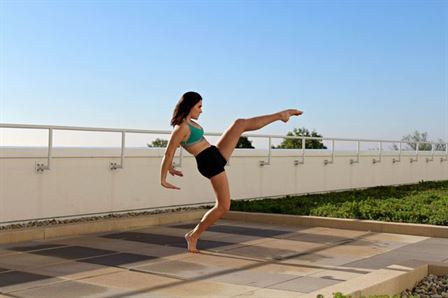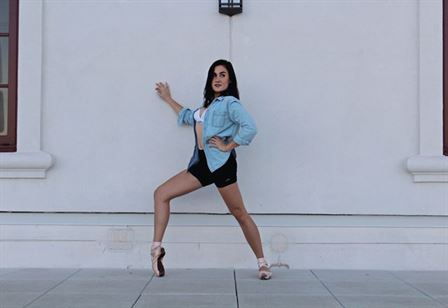
Rebecca English is a senior dance education major with a minor in LGBTQ studies.
Photo courtesy of David Keith.
Q: What is your major?
A: I am a dance education major and an LGBTQ studies minor.
Q: When you did you start dancing?
A: I’ve been dancing since I could walk—about 2 years old. My mom tried to put me in soccer, but she said all I did was chase butterflies and talk to the other team.
Q: When and why did you decide to pursue dance as a career?
A: The year I was in eighth grade, a performing arts high school opened and I decided to audition for the school and make this my life [and] career. Over the years, my goal has changed from dancer on stage to dance teacher at a school.
Q: What type of dance do you specialize in? Can you talk about how you decided that type of dance is your favorite?
A: I don’t know if I would say I specialize in any style of dance yet. I’m too early in my “artist journey” to have that figured out. I love teaching ballet because it is very technical and everything in the body needs to connect to make sense—kind of like how people like math because there are rules. However, I like performing modern movement, like Martha Graham.

Rebecca English finds inspiration for her dancing from world-famous dance teacher Martha Graham.
Photo courtesy of David Keith.
Q: What experiences have you had dancing? What have you learned through dance?
A: I started in a small studio and went to the Academy for the Performing Arts in Union County. I’ve danced in Manhattan, the Prudential Center, touring companies and even the commencement ceremony for Kean University. Now, being a future educator, I try to take what dance has given me into everything I do. I think the most important thing that I have learned is that no matter if you’re the soloist or a dancer in the back, you’re seen and you can touch someone in the audience.
Q: What is your biggest motivation?
A: My biggest motivations are the people who have said this is a “waste of a major.” The first thing all dance majors hear when they say what they’re studying is, “Oh a dancer—that must be so fun.” If you count staying in the studio until 1 a.m. creating, getting up the next day for an 8 a.m. ballet class and constantly feeling like you have old lady bones, then yes, its a blast. Dancers put in more time rehearsing and working on our craft than some athletes and have to still stay up late to teach or study like most students.
Q: How has Montclair State University fostered you as an artist?
A: I was just a dancer before Montclair State’s program. As a senior, I can say I am an artist. The dance faculty at Montclair has taught me to question everything and constantly challenge my peers and myself. In class we are reminded that the “real world” of dance is hard, but we will always walk into an audition refusing to be overlooked.

Rebecca English is currently working to have a
personal piece shown in festivals.
Photo courtesy of David Keith.
Q: Who are your biggest supporters?
A: My biggest supporters are my family, mom, dad, little sister and my two best friends here at Montclair. My family is always a phone call away to listen if I had a bad day or feel like I just cannot make it as an artist. They remind me that with passion and a good work ethic, I can be successful. My two best friends are also my roommates. Without them, I don’t know if I would still be here. We laugh constantly, help and inspire each other and motivate each other when it’s 10 p.m. and we think we just cannot dance any longer.
Q: Who are your biggest inspirations?
A: My biggest inspirations are some of the most world-famous dance teachers and revolutionaries like Martha Graham and Bill T. Jones. Martha Graham created an entire new style of dance when there was only ballet in the world. She also was a huge advocate of women having the same performance opportunities and making women appear strong and powerful on stage—none of that “damsel in distress” or “dying swan” crap. Bill T. Jones is a phenomenal teacher and includes dancers of all race, religion, gender and body type in his work. It has a very interesting affect on the way his pieces look, because they look like people who all met right before the performance and decided to dance together. It makes the piece very human.
Q: What’s your latest project?
A: My latest project is a piece I am trying to have shown in festivals. Its about people who feel constricted by society and have to adhere to the norms. However, when everyone is “normal,” it creates a very boring world. So my dancers are trying to break out of this box and show the world (or audience) who they really are. Even if it looks different, it’s beautiful.



